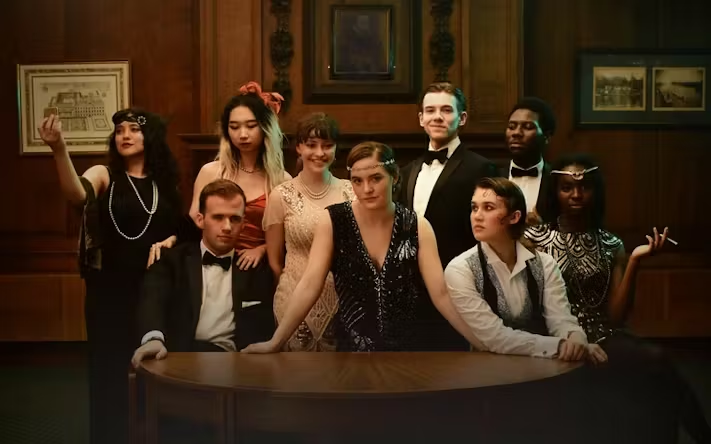If ever there was a show of two halves, this was it. At the interval I was toying with the idea of sneaking out (and that wasn’t just because the people sitting next to me had spent the first ten minutes consuming an entire takeaway meal). By the end I was dabbing away tears and cheering as each actor took a bow.
How did this miraculous conversion take place? What was so wrong, and what so right?
It was only too clear that a huge amount of work had gone into this production. The set is an impressive Art Deco creation, there’s singing, dancing, and a bold twist on the original book. But in the first half it just doesn’t come together.
The deliberate anachronism of using modern songs to populate the aural landscape of 1922 wears its Luhrmann heavily on its sleeve, and the clash of flappers and 70s crooning, for me, simply jarred. The dancing seemed superfluous and exposed: this wasn’t a musical, so why did it briefly behave as though it was one? Half the audience politely clapped like you do at the end of a song; the other half didn’t, as it just seemed awkward. At the climax of the first half there’s a mini-ballet between Gatsby and Daisy that represents the joy of finding each other again. It was well performed, but watching it verged on the embarrassing, like stumbling across your father mowing the lawn in a mankini. I wanted to cry, “Why are you doing this?” The atmosphere of a convincingly narrated story was all it needed – and for Gatsby and Daisy to kiss.
The central, and guiding, creative decision of this adaptation was to make Gatsby a woman: not just played by a woman in the cause of gender-blind casting, but a female character in the world of the story. In places this creaked and stretched credulity (as when she off-handly explains that she fought in the First World War by dressing up as a man, and everyone was fooled). In others it adds depth and a fresh perspective to how we read the text. It means that Daisy’s secret life, hidden from her husband Tom, is not just about an affair with another man, but about the essence of her own identity. And Fitzgerald’s Gatsby undeniably has a sexual appeal that reaches out to the narrator Nick as well as to Daisy. In truth, it feels like a natural and smart creative decision.
But gender-swapping isn’t a substitute for theatrical style, and the first half felt if anything slightly longer than the entire original novel. Late lighting cues, pieces of scenery being hefted around, and overlong scenes added to the sluggish mood.
And then the second half started. The smell of my neighbours’ takeaway had finally dissipated, and the entire experience assumed a new level of focus, passion and – above all – drama. Gone was the dancing, and in its place we had intense confrontations. Gone were the meandering scenes, and now we had a story that built with pace and tension.
Ethan Bareham’s Nick the Narrator was a perfect piece of casting. Watching him and Gillian Konko as Gatsby reminded me of Charles Ryder and Sebastian Flyte in Brideshead Revisited: one awkward, polite, fascinated; the other charismatic, effusive, bent on self-destruction. Eleanor Dunlop was brilliantly poised and icy as Jordan. Flynn Hallman, in a tiny role as Gatsby’s father, moved me to tears. But the show was almost stolen by Fitzroy ‘Pablo’ Wickham as George, the gas-station owner who becomes the deliverer of retribution at the climax of the play. As he pointed his gun in mingled panic and rage, not only the other characters but everyone in the audience froze in fear.
At the end of the day, The Great Gatsby is of course one of the outstanding novels of the Twentieth Century. It doesn’t need too much interference. Bringing it to the stage is in itself an exciting and worthwhile idea. Ultimately Peter Todd’s and Mina Moniri’s adaptation finds its voice, and makes for a powerful, thrilling and moving show. Sure, it takes a while to find that voice. But it’s worth the wait. Don’t leave at the interval.




